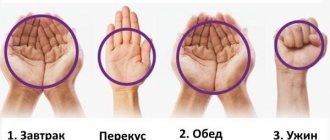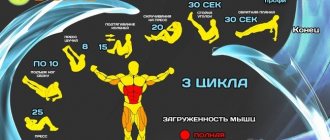General information
A proper diet is the basis of a healthy lifestyle for every person. But, unfortunately, in the modern world, people’s diet is far from ideal. obesity is growing every year . At the same time, not only adults, but also young children are overweight The importance of nutrition for human health is enormous due to its impact on health. Many serious diseases, in particular heart attacks , strokes , atherosclerosis , etc., are associated precisely with an incorrect approach to the formation of a diet. This article will discuss how to properly structure a person’s diet, and how the so-called food pyramid can help with this.
What is the food pyramid?
Since compiling a person’s diet is a serious matter, it must be carried out taking into account the recommendations of nutritionists. The so-called food pyramid will help with this - a simple and extremely understandable method for everyone, according to which you can describe a person’s diet.
The so-called “Harvard Healthy Eating Pyramid” is a system that is widely used not only by American dietetics, but also by nutritionists all over the world. As you can see in the photo, at each level of such a pyramid certain products are placed.
According to the recommendations of the authors of this principle, a person’s daily diet should include as many products as possible, which are located at the base of the pyramid. The higher the products are located in the pyramid, the fewer of them should be on the menu. Accordingly, at the very top there will be those foods that need to be consumed as rarely as possible or completely eliminated.
In addition, it is necessary to adhere to a number of recommendations of the Harvard pyramid:
- Constant monitoring and maintenance of normal weight is important;
- replacing saturated fats with unsaturated ones;
- replacing processed grains with whole grains;
- eat as many fresh vegetables and fruits as possible every day;
- eat protein foods - the list of the healthiest ones includes legumes, nuts, poultry and fish;
- reduce alcohol consumption to a minimum;
- take multivitamin complexes.
That is, the Harvard pyramid is actually a long-term strategy for healthy eating. Its essence is to consume healthy foods that strengthen the body and help reduce the risk of developing various diseases.
Building a pyramid
The food pyramid is built like this:
- Base – it contains three important food groups: fruits and vegetables, which supply the body with vitamins and fiber; whole grains; vegetable fats with polyunsaturated fatty acids. If possible, this food should be included in every meal. Every day you should eat 300 g of fruits and 400 g of vegetables.
- The second step is protein plant products, that is, seeds, nuts, legumes; protein animal products - seafood, fish, poultry, eggs. Foods from this category should be consumed up to 2 times a day.
- The third stage is dairy products, that is, yoghurts, cheeses, fermented milk foods, etc. You should eat 100-200 g of such products per day. If a person is lactose intolerant, milk is replaced with foods containing calcium and vitamin D.
- The fourth step is products whose consumption must be minimized. These are red meats with a lot of animal fats, butter, baked goods made from white flour, pasta, sweets, soda. Also, modern nutritionists have reviewed the beneficial properties and harmful effects of potatoes, and then included them in this part of the pyramid, removing them from the lowest. This is explained by the fact that this vegetable contains a large amount of starch.
If you look at the schematic representation of the pyramid, then on the side of the main pyramid there are pictures with alcohol and a jar of vitamin-mineral complex. High-quality alcohol can be consumed several times a week in small quantities. And complexes of vitamins and minerals should be periodically consumed as a supplement that “covers” the lack of vitamins and minerals important for the body that arises due to a not very balanced diet.
Using the nutrition pyramid, you can formulate your diet in such a way as to ensure the most optimal amount of calories and the supply of substances important for the body. Since the list of products from which a menu can be made is very wide, each person can easily select the products that he likes. After all, in each of the steps of the pyramid, food groups are represented, and not specific foods.
Pay attention to movement and chewing
Nutrition and physical activity are closely related, because nutrition is the receipt of nutrients and energy, and physical activity is the expenditure; There must be a balance between them. Eating high-calorie foods and not moving enough puts you at risk for overweight, obesity, heart disease and other chronic diseases. 20 years ago, the problem of low activity was not as relevant as it is now. People moved more and spent more time away from home.
So what is most important in human nutrition? The most important things are very simple, which may be why people often ignore them. This is regular meals (not 1-2 times a day), varied foods. The process of eating is also very important - try not to read, talk on the phone, watch TV, and chew well.
Main rules of nutrition
- You must follow the rules of the food pyramid and try to bring your menu as close as possible to its principles. Despite the fact that few people manage to organize an ideal diet, these principles will help you introduce the most necessary products into the menu and remove junk food from it.
- It is important to strive to consume only fresh foods. If you can’t cook on your own, then you should choose high-quality semi-finished products. It is better to completely exclude food that is sold ready-made from the diet.
- To provide a truly balanced diet, the list of products must be quite wide. It should include all food groups, but the correct proportions of their consumption should be observed.
- You should use healthy foods as snacks - nuts, fruits, dried fruits.
- Cabbage is a dietary vegetable that should be included in the diet as often as possible. Any type of cabbage - red, white, savoy, kohlrabi, Brussels sprouts, Peking cabbage - is not only rich in vitamins, but also helps reduce the risk of a number of diseases.
- If possible, you should choose low-fat foods. You also need to reduce the amount of sugar, salt and alcohol in your daily diet.
- One of the most important rules is that the food consumed is consistent with physical activity. Excess calories invariably leads to excess weight.
- The benefits of a healthy diet are undeniable. But you shouldn’t expect instant results from switching to a healthy diet. Gradually, a person still notices very important changes for him: normalization of sleep, improved performance, normalization of weight, etc.
The principle of physical activity
In addition to the principle of diversity, the following principles are also characteristic of the food pyramid:
- The principle of proportionality. The point is that it is necessary to adhere to the correct ratio of foods consumed. In the diagram, this rule is reflected in the different widths of the segments. For example, the yellow segment of fats is the narrowest, which means that fats should occupy the very last place in the diet.
- The principle of individuality. Each person is individual. Moreover, this includes not only his gender, age, body structure, but also food preferences. The food pyramid will help you create an individual healthy diet.
- The principle of moderation. The correct diet is not only about the quality of the foods consumed, but also about their quantity. Moderate consumption means not overeating or starving.
- The principle of physical activity. This principle creates a parallel with the other principles and is represented by the formula: varied food physical activity = beautiful and healthy body. We'll talk about this principle in more detail a little later.
The food pyramid should not be taken as some kind of rigid guide to nutrition. From all the variety of products, everyone can create a suitable healthy menu for themselves. And the maximum effect of the health pyramid will only be achieved if the following conditions are met:
- Maximum combination of products.
- Balancing food intake with physical activity.
- Minimizing products from the top of the pyramid.
- Strict adherence to the choice of products from a specific group - there should be no substitution.
- Consume only fresh foods, avoiding prepared foods.
- A competent approach to purchasing products by studying their nutritional value and production date.
One of the principles of the healthy eating pyramid is the principle of physical activity. In the diagram he is represented as a man climbing the stairs. And the essence of this principle is that you can achieve a beautiful body only by combining a healthy diet with physical activity. Nutritionists advise devoting at least an hour a day to the latter.
And in order to replenish the calories lost during physical activity, you need to know how many calories you need to consume. So, for physically active people you will need 2800 kcal, and, for example, for pensioners or people leading a sedentary lifestyle - only 1600 kcal. Based on this, you need to build your diet, using all the principles of the pyramid.
If we take into account athletes who train intensively, they should base their diet on the basis of the following daily calorie values:
- 2500-2800 kcal – for women;
- 2800-4300 kcal – for men.
The healthy eating pyramid has undergone many changes: some adjustments have been made, both qualitative and quantitative, and additions have been made. The principles were also revised. Relatively recently, the principle of physical activity has even come to the forefront, pushing aside the principle of diversity.
Food pyramid for children
When compiling a diet for children, it is necessary to do it in such a way that the nutrition is complete and ensures the proper development and active growth of the child. In addition, it is important for parents to make sure that the taste, color, and general appearance of the dishes are appetizing, otherwise the kids may refuse to eat healthy food.
The food pyramid for adults is the basis for creating menus for children. The only difference is in the products that are required for consumption. The pyramid perfectly visualizes the approach to nutrition that should be practiced when creating a children's diet. Its basis is the most important products for the child, that is, cereals, cereals, vegetables, fruits, meat, fish, eggs, dairy products, nuts, vegetable oils. At the very top of this pyramid are sweets, soda, and confectionery.
Another important point is the drinking regime. From childhood, children need to be taught to quench their thirst with clean drinking water, and not with soda or store-bought juices.
Children should not be given too much freshly squeezed juice. They are, of course, healthier than store-bought ones, but the basis should still be fresh fruits with fiber and dietary fiber.
From childhood, the child must get used to drinking milk and eating dairy products, which contain a lot of calcium, which is the basis for skeletal growth.
Of course, animal proteins and iron contained in meat are no less important.
As for bread, it is also important for children, as it contains many microelements . But if wholemeal bread is very healthy, then baked goods and white bread products are much less beneficial. But at the same time, a child who loves buns runs the risk of gaining weight quickly.
In general, the approach to organizing a healthy diet for children involves following the same rules as when organizing a healthy menu for adults. The main thing is to teach your baby the basic rules of healthy eating and do everything to make him love healthy dishes.
Sample menu
- For breakfast, the child should consume milk or dairy products. It can be cheese, kefir, cottage cheese, yogurt. Vegetables and toast are also suitable.
- For lunch, which is the main meal, children should definitely eat protein foods - meat or fish, as well as vegetables.
- Dinner should not be as plentiful as breakfast. You can offer your child porridge with fruit or milk soup if he prefers a different food in the morning.
In addition, preschoolers and especially schoolchildren should definitely have several snacks throughout the day.
- Second breakfast - cheese, boiled meat with vegetables, fruits.
- Second snack - between lunch and dinner you can eat nuts, dried fruits, yogurt.
- During the day, the child should drink at least 1 liter of clean water.
Vegetarians have their own pyramid
The vegetarian food pyramid, unlike the traditional ones, does not insist that you can eat well only if you eat meat and milk, poultry, fish and eggs.
The basis of a vegetarian’s diet, according to the pyramid, is cereals in combination with legumes and cereals.
Animal protein contained in meat includes the entire necessary set of amino acids, while plant foods lack one or the other. Therefore, only by combining and consuming beans and grains at the same time, vegetarians can compensate for the deficiency of amino acids in the body.
The second most important thing in a vegetarian's diet are vegetables and fruits. Protein-rich foods are the third step of this pyramid.
This includes cheese, eggs, milk or low-fat cottage cheese, soy products, seeds and nuts
Food rich in protein is the third step that this pyramid includes. This includes cheese, eggs, milk or low-fat cottage cheese, soy products, seeds and nuts.
Well, at the very top are fats and sweets. You shouldn’t completely remove them from your diet, because they contain many useful substances. It is better to choose them wisely.
From fats, you can consume unrefined vegetable oil and ghee. And for sweets you can eat dark chocolate and dried fruits.
Proper diet: how to make it?
The definition of the concept “diet mode” is as follows: it is a qualitative and quantitative characteristic of nutrition (time of intake, frequency, calorie content, chemical composition, human eating behavior).
If a person practices the correct diet, then his body receives the nutrients necessary for life in a timely manner. Food has a direct impact on well-being, appearance, performance and overall health. The fact that poor nutrition can provoke a weakened immune system , impaired mental and physical development, as well as a decrease in performance, is also emphasized by the WHO - World Health Organization.
Therefore, when forming the right diet for children and adults, some very important points should be taken into account. When planning your daily diet, it is important to consider several factors.
Nutrients
micronutrients and macronutrients are in the foods consumed .
Protein, carbohydrates, fats and fiber are macronutrients. Calculation of how many of these substances a person needs is based on height, age, weight, lifestyle characteristics and energy expenditure. If we talk about averages, a person should get about 10-20% protein from food, about 10-30% fat and 50-70% carbohydrates. Accordingly, excess protein, fats or carbohydrates are harmful to the body.
Vitamins and minerals are micronutrients. Currently, scientists identify more than one hundred micronutrients contained in food. But the most important for the body are 13 vitamins and 15 minerals. With their deficiency, pathological conditions can develop.
Water
Part of a balanced diet is water. For the body, this is an “essential” product. It is important not only for life, but also for the process of losing weight, since water accelerates the breakdown of fats. Therefore, you should drink up to 2 liters of water per day. There is a special formula for calculating its amount in the daily diet. A woman needs to drink an amount of water at the rate of 30 ml per 1 kg of body weight, a man - 35 ml per 1 kg of body weight. People who play sports should take special care of their water balance.
Calorie content
This indicator determines the amount of energy produced in the body when consuming food. Calorie content and nutritional value are different concepts. The latter determines the amount of carbohydrates, fats and proteins in foods. When compiling a diet, it is necessary to choose low-calorie foods that still have high nutritional value. Protein products are important, since protein is the main “building” material in the body. The benefits of meat and fish for the body are undeniable - these are one of the main sources of proteins.
A balanced and healthy diet requires that a person’s energy expenditure and food intake must be adequately compared. That is, the daily caloric intake should be such as to provide, but not exceed, energy expenditure.
When compiling a diet, it is necessary to take into account the so-called “empty calories”, which are absolutely useless for the body. After all, such products provide energy for a very short period and do not contain important nutritional components. The result of their frequent and excessive consumption is excess weight. Therefore, it is very important to choose desserts correctly, ignoring sources of “empty calories” - soda, pastries, and confectionery. However, you shouldn’t give up desserts completely. The importance of desserts for a person lies, first of all, in receiving pleasure from such food. And a properly selected dessert (fruits, dishes made from low-fat cottage cheese, fermented milk desserts) may well be the conclusion of a tasty and healthy meal.
Sample menu for weight loss
A diet based on the principles of the food pyramid allows you to lose weight gradually and without harm to your health. You don't have to count calories on a calculator and give up most foods. When creating a menu, it is enough to use common sense.
Here is an example menu for you:
- Breakfast: oatmeal on water with pieces of dried fruit (150 grams);
- First snack before 12:00: one orange;
- Lunch: grilled fish (150 grams), a slice of whole grain bread, a salad of fresh cucumbers and tomatoes with herbs, dressed with olive oil;
- Second snack before 16:00: low-fat yogurt without sugar;
- Dinner: salad of leafy vegetables with shrimp, seasoned with lemon juice, a handful of oat bran.
As you can see, the diet complies with the rules of both the classical and new pyramids. The basis is cereals and fresh fruits, there is one serving of protein and dairy products. There is very little fat.
The food pyramid combines the main principles of a healthy menu in one small picture. It is easy to use, and thanks to its flexible rules, it allows you to create an individual program taking into account age, health status, physical activity and other factors. There are no pseudoscientific distortions in the pyramid that many express diets suffer from.
Always remember that proper nutrition is the easiest and safest way to achieve a beautiful appearance and a slim figure.
List of sources used in writing the article:
- Jesse Russell, The Food Pyramid, Book on Demand, 2013.
- “Dietetics. Leadership", ed. Baranovsky A.Yu., Peter Publishing House, 2020.
- W. Willett, P. Skerrett “The Chemistry of Healthy Eating”, Potpourri Publishing House, 2014.
- https://www.hsph.harvard.edu/nutritionsource/healthy-eating-plate/.
- https://www.choosemyplate.gov/WhatIsMyPlate.
- https://www.ncbi.nlm.nih.gov/pubmed/26590418.
How to create the right diet
To help you figure out how to create your diet correctly, you can use the example of a daily diet, which contains the corresponding table
Adult diet: table
| Eating | Products |
| Breakfast | Boiled egg, toast with a piece of cheese (50 g), milk or freshly squeezed juice 250 g. |
| Dinner | Chicken cutlets (150 g), durum spaghetti (200 g), grilled vegetables (100 g), orange. |
| Dinner | Baked fish (100 g), stewed vegetables (150 g), toast, apple. |
| Snacks (2-3 per day) | Yogurt, bread, fruit. |
Using this example, you can create many diet options so that your weekly meal schedule is varied and healthy.
Harvard Pyramid 1992
This food pyramid was developed in 1992 by nutritionists at the Harvard School of Nutrition in the USA. This was the first option, and it looked like this: several tiers (like shelves in a closet) and the amount of food that you need to eat every day. At the foot of the pyramid there are daily sports exercises (exercises, jogging, etc.), and above, tier by tier towards the top of the pyramid there is food. Guys and men need approximately 2 liters of clean water per day, and girls and women need 1.5 liters of water. Alcohol should be limited, according to nutritionists from Harvard.
The foods in the food pyramid are arranged like this:
The 1st floor of the food pyramid is foods that need to be consumed every day in our lives. Complex carbohydrates: durum wheat pasta, wholemeal bread (not white), various cereals, brown rice, buckwheat, bran. Vegetable fats: olive oil, vegetable oil, rapeseed oil, corn oil, etc.
2nd floor - preferably fresh vegetables in abundance (cucumbers, tomatoes, radishes, onions, dill, herbs, lettuce, etc.). A variety of fruits (apples, pears, bananas, kiwis, grapefruits, tangerines, oranges, etc.), berries (raspberries, strawberries and others) - 2-3 servings per day.
3rd – Various nuts (cashews, walnuts, almonds, etc.), legumes (peas, beans, etc.) – 1-3 servings per day.
4th floor of healthy eating - fish (salmon, trout, etc.), chicken (preferably chicken fillet without skin and a minimum of animal fat), eggs, these products are 0-2 servings in the daily diet.
Level 5, approaching the top. Milk 0.5-1.5% fat and low-fat dairy products (ryazhenka, kefir, etc.).
Level 6 (top). Eat this food rarely, because... it is not useful. For children and for weight loss, the last thing you need to do is consume such food. Red meat, butter, sausages, margarine, potatoes, sweets, cakes, pastries, carbonated drinks, alcoholic drinks, white bread.
Vitamins and minerals can be added to your daily menu if you do not get enough vitamins from food. You can consult a specialist about additional vitamins in your diet. If you lead an active lifestyle, play sports or want to lose weight, most likely you can take vitamins in courses, as they have a beneficial effect on the body. Never self-medicate; it is better to consult a doctor or nutritionist.
Alcohol is harmful to your health, both for adults and children and for those who want to lose weight. Adults can rarely drink, preferably red wine. Take care of your health while you are young and energetic.
The basic principle of Harvard specialists is this: foods that are at the bottom of the pyramid should be consumed every day, evenly. And going from bottom to top, you need to reduce the amount of food per day. It is advisable to exclude or minimize those at the very top of the healthy menu pyramid altogether, because they do not bring any benefit to you (for children and for weight loss, you need to exclude them 100%).











